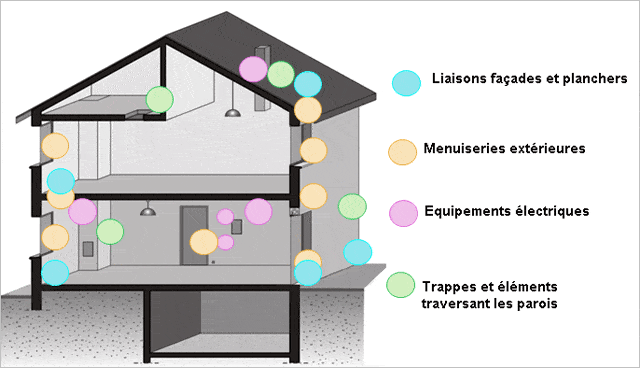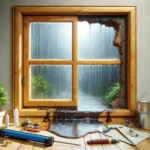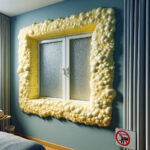Improving the energy efficiency of your home, in order to reduce your heating bill and improve your comfort, depends on small examinations that will identify the weak points of the house.
Pay particular attention to the following areas: air leaks, parched caulking joints, deficient wall insulation, disjointed floor slats, the non-visible part of your power outlets, the partition/floor (smooth) junctions hidden behind the baseboards, the partitions/ceilings sometimes embellished with wide angle moldings, etc.

 High accuracy in detecting air leakage requires a thermographic inspection. In the interest of professional performance, Elite Calfeutrage refers you to inspectors accredited by ITC, thermography inspector performs high-precision assessments thanks to a High Definition infrared camera.
The Government Energy Efficiency Agency offers an “Infiltrometry” test for your home. This test is free under certain conditions and for low-income families. This test identifies and measures the air exchanges that take place in the house, it reveals the weak points of its waterproofing and its problems of internal caulking. You can also, but it’s less effective, do this detection of air leaks yourself…
High accuracy in detecting air leakage requires a thermographic inspection. In the interest of professional performance, Elite Calfeutrage refers you to inspectors accredited by ITC, thermography inspector performs high-precision assessments thanks to a High Definition infrared camera.
The Government Energy Efficiency Agency offers an “Infiltrometry” test for your home. This test is free under certain conditions and for low-income families. This test identifies and measures the air exchanges that take place in the house, it reveals the weak points of its waterproofing and its problems of internal caulking. You can also, but it’s less effective, do this detection of air leaks yourself…
Air infiltration and waterproofing of the house

Energy saving
The environmental aspect is a citizen’s concern, saving energy is acting for the environment, acting for ecology. This should not be put in second place.Increased comfort of the home
A house whose warmth is harmoniously distributed is more comfortable, no place colder than another, no thrill in a passage a little neglected or a corner of room left to leak air.Financial savings
Should we demonstrate the reality of theimpact on the heating bill (and possibly the air conditioning bill) is in the range of 5% to 10%.Longevity of the house
A well-caulked waterproof house, both indoors and outdoors, is less exposed to water infiltration that rots the structure, insect infestations and general humidity. It stays in good condition for longer.Taking stock of air infiltration
 High accuracy in detecting air leakage requires a thermographic inspection. In the interest of professional performance, Elite Calfeutrage refers you to inspectors accredited by ITC, thermography inspector performs high-precision assessments thanks to a High Definition infrared camera.
The Government Energy Efficiency Agency offers an “Infiltrometry” test for your home. This test is free under certain conditions and for low-income families. This test identifies and measures the air exchanges that take place in the house, it reveals the weak points of its waterproofing and its problems of internal caulking. You can also, but it’s less effective, do this detection of air leaks yourself…
High accuracy in detecting air leakage requires a thermographic inspection. In the interest of professional performance, Elite Calfeutrage refers you to inspectors accredited by ITC, thermography inspector performs high-precision assessments thanks to a High Definition infrared camera.
The Government Energy Efficiency Agency offers an “Infiltrometry” test for your home. This test is free under certain conditions and for low-income families. This test identifies and measures the air exchanges that take place in the house, it reveals the weak points of its waterproofing and its problems of internal caulking. You can also, but it’s less effective, do this detection of air leaks yourself…
Detect air leaks yourself
One of the simplest methods is to walk a candle along all the weak points mentioned above. The sensitivity of the flame will not be able to cheat, it will shudder at the slightest trickle of air. You can also make an air detector with an ultra-light sheet of paper (a type found in gift bags), which you will have cut into long fringes. It will only be necessary to hold it between two fingers to detect drafts as you pass by. Plan this test before winter to do the work before it gets very cold. The interior places to inspect are numerous:- Inner angle mouldings
- Baseboards
- Rings around windows and doors
- Poorly placed or unsealed windows
- Sliding windows
- Guillotine windows
- Space around the doors
- Switches
- Electrical sockets
- Ceiling
- Floor seals
- Efficiency of breakers
- Mechanical ventilation
- Bathroom Vent
- Mailbox slot in some doors
- Cat flaps.



